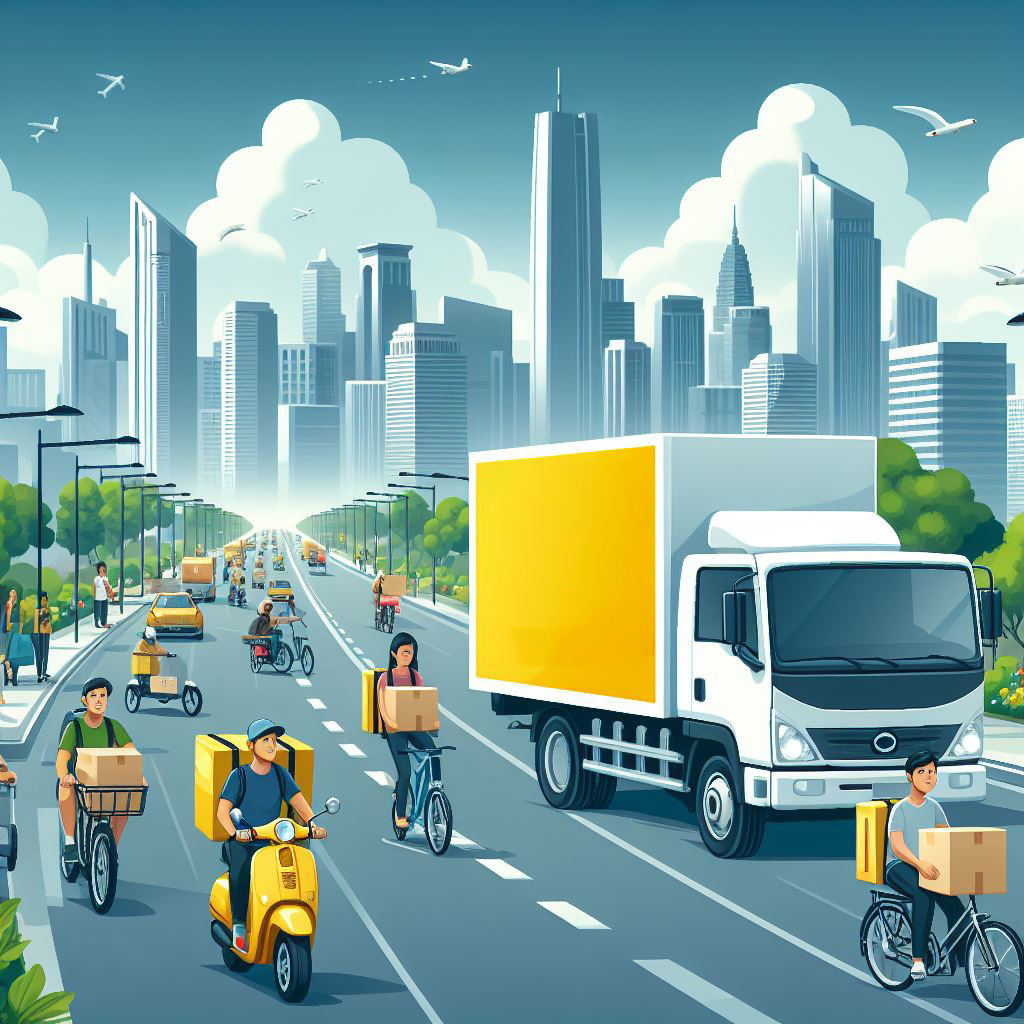AI for Last-Mile Delivery Optimization
In a recent survey by Convey, Inc., a staggering 98% of over 1,500 shoppers agreed: that shipping plays a pivotal role in brand loyalty. What’s more, 84% revealed they’re unlikely to return after just one negative delivery experience. As e-commerce giants like Amazon continue to redefine delivery standards, tracking a package is no longer sufficient for today’s discerning consumers.
This is where AI enters, the game-changer in last-mile delivery optimization. By utilizing AI, businesses can revolutionize their processes: from route optimization and predictive analytics to automated logistics and enhanced customer communication. In this blog, we are setting out to explore the evolving landscape of last-mile delivery and the critical impact it has on customer loyalty.
The Changing Landscape of Last-Mile Delivery
The last mile is not just the final leg of the delivery journey; it’s the ultimate point of interaction between the business and the customer. Positive last-mile experiences have become integral to building and maintaining customer loyalty. In an era where brand loyalty can be fragile, ensuring a smooth and reliable delivery process is a powerful tool for businesses looking to create lasting impressions.
Traditional last-mile delivery operations are facing a barrage of challenges in meeting these changing customer demands. Inefficiencies in route planning and execution lead to delays and increased operational costs. Failing to adapt to evolving customer expectations risks not only customer satisfaction but also market relevance. In a hyper-competitive e-commerce landscape, businesses must recognize the urgency to optimize last-mile delivery or risk being left behind.
Key Challenges in Traditional Last-Mile Delivery
The challenges in traditional last-mile delivery are multifaceted. From the inability to meet the demand for speedy deliveries to the rising operational costs associated with inefficient processes, businesses relying on outdated delivery models face a critical juncture. Perhaps most crucially, the impact of poor last-mile experiences on customer retention and brand loyalty cannot be overstated.
Speed and Timeliness
- Inability to meet the growing demand for faster deliveries.
- Difficulty in achieving timely delivery windows, especially with the rise of same-day and on-demand expectations.
Operational Inefficiencies
- Lack of efficient route planning and optimization, leading to longer delivery times and increased fuel costs.
- Ineffective coordination between warehouses, distribution centers, and delivery teams, resulting in delays and added complexities.
Rising Operational Costs
- Higher fuel expenses due to inefficient route planning and suboptimal delivery schedules.
- Increased labor costs associated with manual processes in warehouses and during the delivery phase.
Inaccurate Tracking and Communication
- Limited visibility and real-time tracking capabilities for customers, leading to frustration and uncertainty.
- Ineffective communication channels, making it challenging for customers to stay informed about their delivery status.
Last-Mile Traffic and Congestion
- Challenges posed by urban congestion and unpredictable traffic conditions, contributing to delays and increased delivery times.
- Difficulty in navigating densely populated areas, leading to inefficiencies in the last leg of the delivery process.
Lack of Flexibility
- Inability to adapt to changing customer preferences and delivery expectations, such as flexible delivery windows or alternative delivery locations.
- Rigidity in delivery schedules and processes that do not cater to the dynamic nature of modern consumer behavior.
The Crucial Role of AI in Last-Mile Delivery
AI changes the way businesses approach the intricate process of getting packages from the warehouse to the doorstep. Beyond being a tech buzzword, AI represents a profound shift, leveraging advanced algorithms to enhance the efficiency, precision, and overall effectiveness of last-mile delivery.
At the heart of AI’s role in last-mile delivery is its ability to analyze vast amounts of data. This includes historical delivery data, real-time traffic conditions, weather forecasts, and even customer preferences. AI algorithms process this data, identifying patterns and deriving insights that would be challenging for traditional methods to uncover.
How AI Optimizes Last-Mile Delivery
Route Optimization
Imagine your package taking the quickest route to your doorstep. That’s the magic of AI in last-mile delivery. Here’s how it works: AI algorithms dive into a treasure trove of data, analyzing the history of delivery routes, real-time traffic conditions, and even upcoming weather forecasts. It’s like having a brilliant navigator that considers every variable to chart the most efficient path.
AI learns from the past. By studying how deliveries were done before, it figures out patterns and optimal routes. But that’s not all – AI doesn’t stop at history. It stays sharp in real-time, constantly updating itself with the latest traffic info. So, if there’s a jam or a shortcut, AI knows and adjusts the route accordingly. The result? Faster deliveries and less fuel consumption. AI’s genius lies in crafting routes that dodge traffic snarls and pick the speediest paths.
Predictive Analytics for Accurate Delivery Windows
Uncertainty about when a package will arrive can be a source of frustration for customers. Enter AI with its predictive analytics prowess, transforming the guessing game into a precision art. Leveraging this technology, AI foresees accurate delivery windows by delving into a diverse array of factors – historical data, traffic patterns, and even external events that might throw a curveball into delivery schedules.
Here’s the magic at work: AI analyzes the historical data of deliveries, learning from patterns and trends. It understands the ebb and flow of delivery demands on different days and times. But AI doesn’t stop there; it’s forward-thinking. Predictive analytics means it can anticipate future scenarios based on the current state of affairs. If there’s a special event causing traffic or a weather event brewing, AI factors it in, adjusting its predictions accordingly.
The real value shines when businesses communicate these accurate delivery times to customers. Imagine knowing precisely when your package will arrive. No more waiting around all day – AI’s predictive capability eliminates uncertainty, contributing to enhanced overall satisfaction.
Automated Warehouse Operations
In the hustle and bustle of last-mile delivery, the warehouse holds the key to efficiency. From order picking to packaging, AI’s automation prowess reshapes how warehouses operate, introducing a new era of efficiency and reliability.
AI-driven systems in the warehouse operate like clockwork. They don’t just pick and pack; they do it with meticulous precision. AI has learned the warehouse like a seasoned expert, studying the patterns of demand, the layout of products, and the most efficient way to fulfill orders. This means a reduction in manual labor, as automated systems take the lead in selecting the right products with accuracy that rivals the human touch.
The impact of this automation is twofold. First, it accelerates the pace of warehouse operations. AI doesn’t need breaks or vacations—it tirelessly operates 24/7, ensuring that orders are fulfilled swiftly and efficiently. Second, it minimizes errors. By eliminating the potential for human error in the picking and packing process, AI ensures that the correct products are selected and packaged accurately for delivery.
Real-Time Communication with Customers
The DispatchTrack’s 2022 Big and Bulky Delivery Report speaks volumes – 90% of customers want to keep tabs on their orders. While not everyone insists on real-time tracking, the unanimous desire is clear: customers want to know what’s happening with their deliveries. This simple expectation has a profound impact on their loyalty and choice of retailers.
Now, meet AI – the communication maestro. AI understands that customers crave updates, and real-time tracking is its solution. Through this feature, AI ensures customers can peek into the status and location of their orders whenever they want. It’s not just about satisfying curiosity; it’s about building trust and loyalty through transparency.
Our findings emphasize a crucial point: meeting this expectation isn’t just nice; it’s necessary. A whopping 60% of customers are ready to explore other retailers if real-time tracking and clear communication aren’t on the table. In the competitive world of last-mile delivery, providing real-time updates becomes a game-changer, securing customer loyalty and encouraging repeat business.
The Future of AI in Last-Mile Delivery Optimization
Autonomous Delivery Fleets
AI stands as the driving force behind the revolutionary concept of autonomous delivery fleets. By incorporating self-driving vehicles and drones into last-mile operations, AI aims to significantly cut labor costs, enhance delivery speed, and reach locations challenging for human access. These autonomous vehicles operate 24/7, providing faster and more convenient delivery options. Notably, Amazon’s Prime Air delivery drone service exemplifies the practical implementation of automated delivery, utilizing small drones guided by GPS to achieve rapid deliveries within a remarkable 30-minute timeframe.
Drone Delivery
The evolution of drone delivery, set to transform logistics in the next five years, is predominantly driven by AI technologies. Organizations like Amazon, Walgreens, and UPS have already tested and implemented drone deliveries in their logistical operations. The pandemic has further accelerated the demand for drone delivery, making it a competitive market. Advancements in battery technology pave the way for drones to carry larger payloads over extended distances, rendering them suitable for last-mile deliveries in both urban and remote areas.
Robotic Warehousing and Sorting
Logistics giants such as Amazon and FedEx are at the forefront of integrating advanced robotic warehousing and sorting systems into their operations. AI is harnessed to automate the storing, organizing, and sorting of packages within distribution centers, paving the way for enhanced order fulfillment speed and reduced errors.
Intelligent robotic systems, soon to seamlessly collaborate with human workers, will navigate warehouses with efficiency. These systems will retrieve and shelve items, optimizing storage space and streamlining logistics operations. While not strictly confined to the narrow definition of the last mile, these innovations have profound implications for last-mile logistics, contributing to the expected doubling of the warehouse robotics market over the next five years.
Wrapping Up
As we conclude our exploration of last-mile delivery optimization, it becomes evident that AI isn’t merely a technological addition but a transformative force reshaping the logistics landscape. The core strength of AI lies in its ability to enhance efficiency across the entire delivery process.
AI’s contribution to last-mile logistics goes beyond mere speed; it introduces a customer-centric paradigm. Real-time communication, adaptive flexibility, and personalized services based on customer behavior analysis redefine the delivery experience, turning it into a tailored journey that resonates with individual preferences.
Ready to revolutionize your business with the limitless potential of Artificial Intelligence? RTS Labs is your trusted ally in the AI landscape, offering top-tier consulting services designed to elevate your operations and propel your success.






